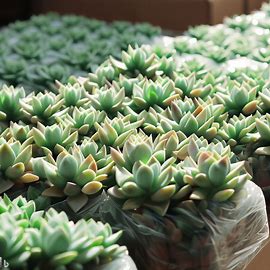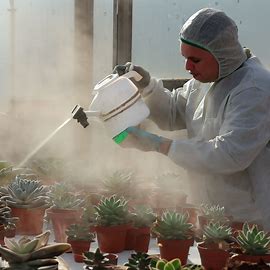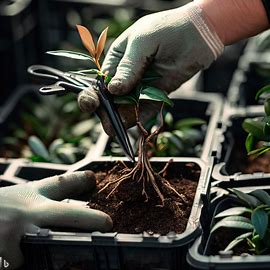Plants are the perfect companions for any lonely windowsill or drab desktop, and succulents in particular steal the show with their unique shapes and vibrant colors. But what happens when you desire to share your prickly love from afar?
Navigating through this process doesn’t have to be as thorny as it sounds. We’ll guide you step by step on how to ship succulent cuttings and keep things safe and smooth during transit while also keeping our beloved plants stress-free!
Are you ready for an adventure in the postage of precious cargo like no other? Fasten your seatbelt as we dive into the world of packaging peccadilloes and postal peculiarities; all in our quest to ensure your succulent babies arrive safely in their new home.
Proper Preparation of Succulent Cuttings for Shipment

When it comes to shipping succulent cuttings, proper preparation is crucial to ensure their safety and health during transit.
Follow these steps to prepare your succulents before sending them off:
- First, allow the cuttings to callus over. This process involves leaving the cut ends exposed in a dry environment for a few days until they form a protective layer. This step minimizes the risk of rot and helps prevent damage during shipping.
- Next, remove any excess leaves from the stem of each cutting. While you want some leaves for photosynthesis and growth, having too many can increase the chances of moisture buildup and potential rot during transportation.
Inspect each cutting carefully for signs of pests or diseases. It’s best not to ship any infected or infested plants as this can spread harmful organisms to other gardens or collections.
The Right Packaging Materials
Choosing suitable packaging materials is essential in protecting your succulent cuttings during shipment. Here are some recommended options:
1. Start with sturdy cardboard boxes that provide enough space for the cuttings without allowing excessive movement inside.
2. Line the bottom of the box with newspaper or packing peanuts for cushioning. This will help absorb shocks and minimize damage caused by rough handling during transit.
3. Consider using plastic containers with secure lids instead of traditional boxes if you have delicate or fragile varieties that require extra protection against compression.
4. Include bubble wrap around individual plants or groupings of smaller ones within the package. This added layer provides insulation against temperature fluctuations and safeguards against accidental impact while in transit.
5. Label your package as “Fragile” along with clear instructions on how it should be handled properly throughout its journey—this will alert couriers and postal workers about its delicate contents.
Moisture Control Measures for Succulents During Transit

Succulent cuttings require careful moisture control during transit to prevent dehydration or excessive humidity buildup.
Follow these steps to ensure their well-being:
1. Before packing, allow the soil around the cuttings to dry out slightly but not completely. This will help avoid excess moisture that can encourage rotting while in transit.
2. Wrap the roots of each cutting with some damp sphagnum moss or paper towel before placing them in a plastic bag. This will provide necessary humidity without causing waterlogging and aid in maintaining optimal moisture levels during shipment.
3. Avoid watering your succulent cuttings immediately before shipping, as this can increase the chances of mold growth and plant damage due to excessive moisture.
Securing the Cuttings in Boxes or Containers

Securing your succulent cuttings properly within their packaging is vital to prevent movement and potential damage en route.
Here’s what you should do:
1. Place each cutting securely inside its own compartment to minimize contact between plant parts during transit—it’s best if they don’t touch one another directly.
2. Use organic cotton padding around each cutting for additional cushioning while also allowing some air circulation—a tightly packed box might cause heat buildup, leading to unfavorable conditions for your plants.
3. Fill any empty spaces with crumpled newspaper or more bubble wrap—this will further stabilize and protect the contents by preventing shifting within the package.
4. Seal the box tightly using strong packaging tape—make sure it’s secure but not too tight as this can damage delicate stems or foliage.
Creating an Ideal Temperature Environment
Maintaining suitable temperature conditions throughout the transportation is crucial for ensuring the successful delivery of your succulent cuttings. Consider these tips:
- Check weather forecasts along your intended shipping route—the goal is to avoid extreme temperatures that could harm your plants. If temperatures are unsuitable at either end, consider delaying shipment until conditions improve—or opt for expedited courier services that prioritize temperature control.
- During hot weather, use ice packs to help keep the package cool while avoiding direct contact with the plants. Wrapping the ice packs in a cloth or paper towel will prevent condensation from affecting your cuttings.
- If shipping during colder months, include heat packs designed for plant shipments to provide an additional source of warmth and protect against frost damage.
Shipment Timing and Choice of Courier Service
Timing is crucial when it comes to sending succulent cuttings by mail. Selecting a reliable courier service can also ensure safer delivery. Here’s what you should know:
- Avoid shipping during extreme weather conditions such as heat waves or freezing temperatures—this can significantly increase the chances of damage to your plants.
- Consider using expedited or priority shipping options since they typically offer faster transit times and better temperature-controlled facilities when compared to regular postal services.
- Research couriers known for their experience in handling live plants, especially delicate ones like succulents. Look for reviews or testimonials from other plant enthusiasts who have successfully shipped their own cuttings before making a selection.
- Providing accurate addresses and contact information is essential in case any issues arise during transit—make sure both yours and the recipient’s details are clearly visible on the package.
Instructional Notes for Recipient on Receiving End
Including instructional notes alongside your shipment can help recipients properly care for their new succulent cuttings upon arrival. Consider these tips:
- Provide detailed care instructions specific to each succulent variety—for example, watering frequency, light requirements, and ideal potting mix composition.
- Remind recipients to unpack their succulent cuttings immediately upon receiving them—to reduce stress on the plants caused by extended periods inside packaging materials
- Encourage recipients to contact you if they have any questions or concerns about caring for their newly arrived succulents. Let them know you’re happy to provide guidance and support even after delivery.
Ensuring Safe Delivery – Dealing with Potential Shipping Issues
Despite taking all the necessary precautions, things can sometimes go wrong during transit. Here’s how to handle potential shipping issues:
If your package is delayed or takes longer than expected to arrive, contact the courier service first and provide them with your tracking number—they will be able to provide more information on its whereabouts.
In case of package damage or mishandling, document everything by taking photos before opening it. This evidence will be useful when contacting the courier for reimbursement or assistance in resolving any damages caused during shipment.
Immediately inspect your succulent cuttings upon arrival—any signs of damage should be documented and brought to the attention of both the courier service and recipient if necessary.
Remember that accidents can happen despite all efforts—offer solutions such as replacing damaged plants or providing guidance on salvaging healthy parts from injured ones to ensure customer satisfaction even in unfortunate circumstances.
Final Thoughts
By following these step-by-step guidelines for shipping succulent cuttings, you’ll increase their chances of arriving at their destination safely and thriving in their new homes.
Help spread joy and happiness by sharing these beautiful plants while ensuring they are well-protected throughout their journey!

